Cookery Course Assignment: Leadership, Management, and Team Dynamics
VerifiedAdded on 2022/10/11
|23
|5641
|12
Report
AI Summary
This cookery course assignment delves into various aspects of leadership and management within an organizational context. The assignment begins by exploring the roles of a manager, including interpersonal, informational, and decisional roles, and then moves on to examine the expectations management has of employees, such as commitment, honesty, enthusiasm, dependability, and the ability to accept feedback. The report further analyzes performance management systems, highlighting their contributions to individual staff development, including communication, development, motivation, and conflict resolution. It then contrasts six distinct leadership styles, namely visionary, coaching, democratic, affiliative, commanding, and pacesetting, evaluating their respective features and impacts. The assignment also addresses how leaders can foster supportive and open communication, providing ten practical examples. Moreover, it outlines eleven essential characteristics of effective leadership, such as influence, vision, credibility, and integrity, and then identifies key characteristics of effective teams, emphasizing communication, common goals, equal contribution, support, diversity, leadership, organization, fun, and regular review. Finally, the report discusses how motivational theories, including Maslow's hierarchy of needs and equity theory, can be applied to meet individual and team needs, enhancing performance and management effectiveness.
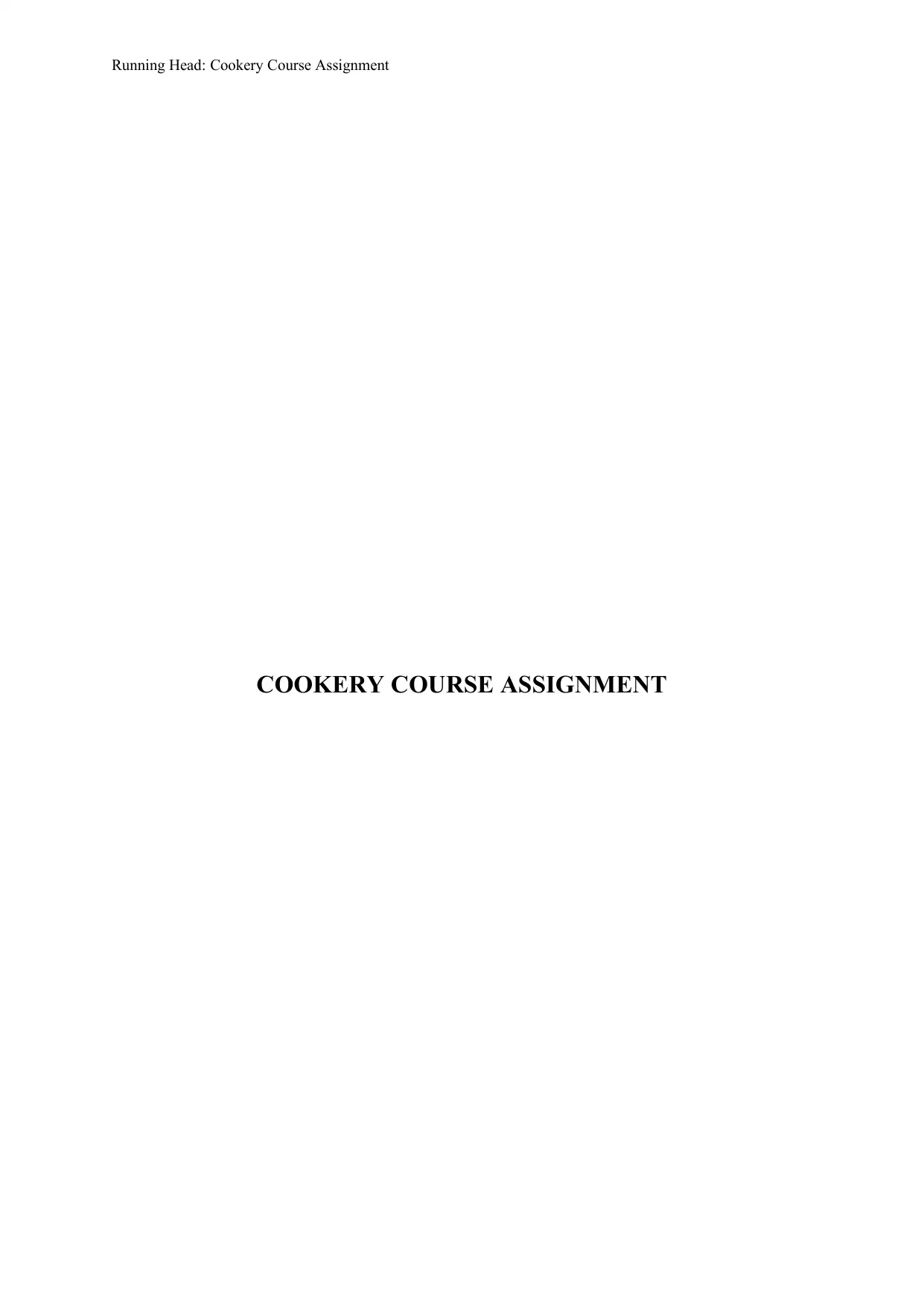
Running Head: Cookery Course Assignment
COOKERY COURSE ASSIGNMENT
COOKERY COURSE ASSIGNMENT
Paraphrase This Document
Need a fresh take? Get an instant paraphrase of this document with our AI Paraphraser
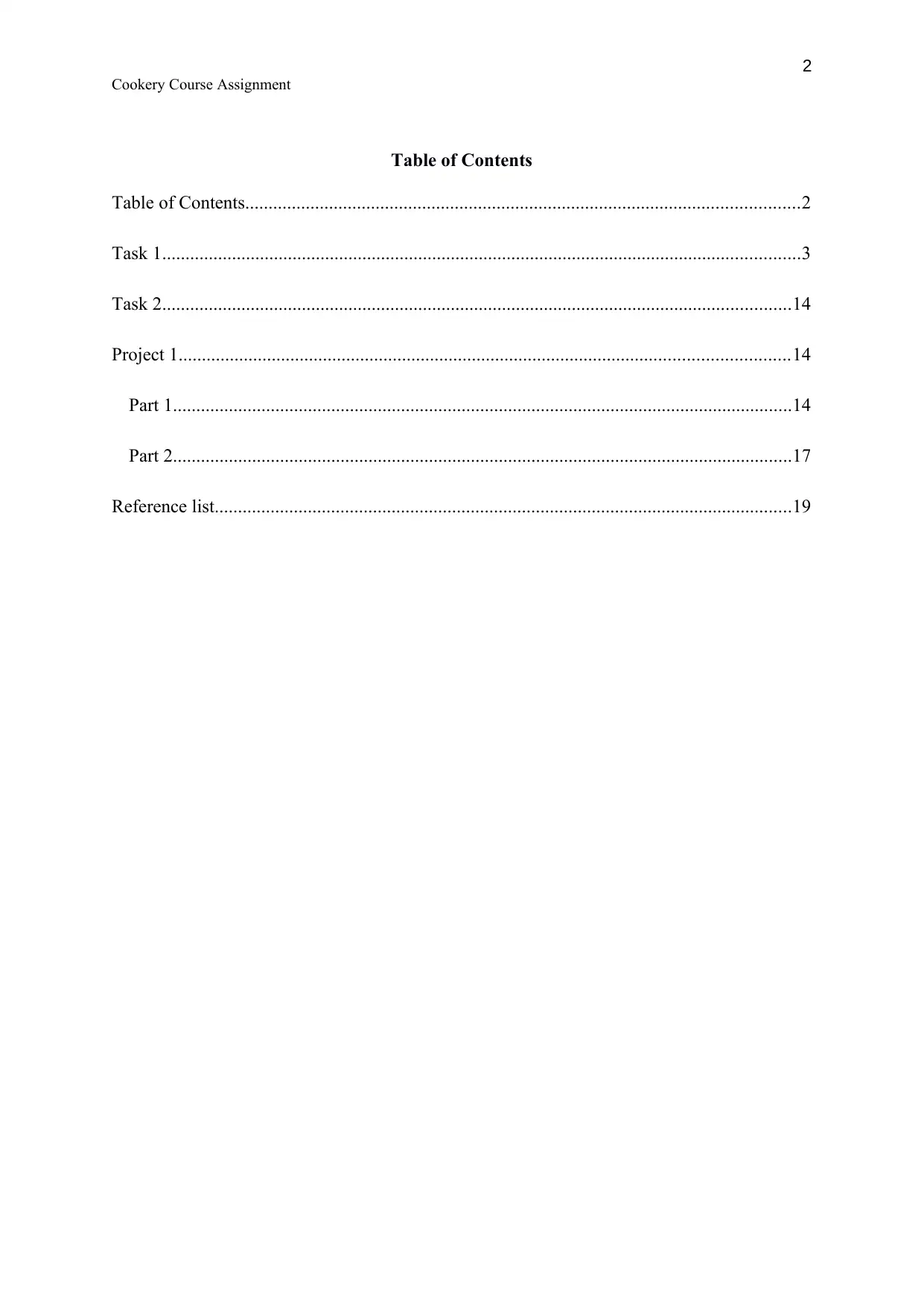
2
Cookery Course Assignment
Table of Contents
Table of Contents.......................................................................................................................2
Task 1.........................................................................................................................................3
Task 2.......................................................................................................................................14
Project 1...................................................................................................................................14
Part 1.....................................................................................................................................14
Part 2.....................................................................................................................................17
Reference list............................................................................................................................19
Cookery Course Assignment
Table of Contents
Table of Contents.......................................................................................................................2
Task 1.........................................................................................................................................3
Task 2.......................................................................................................................................14
Project 1...................................................................................................................................14
Part 1.....................................................................................................................................14
Part 2.....................................................................................................................................17
Reference list............................................................................................................................19
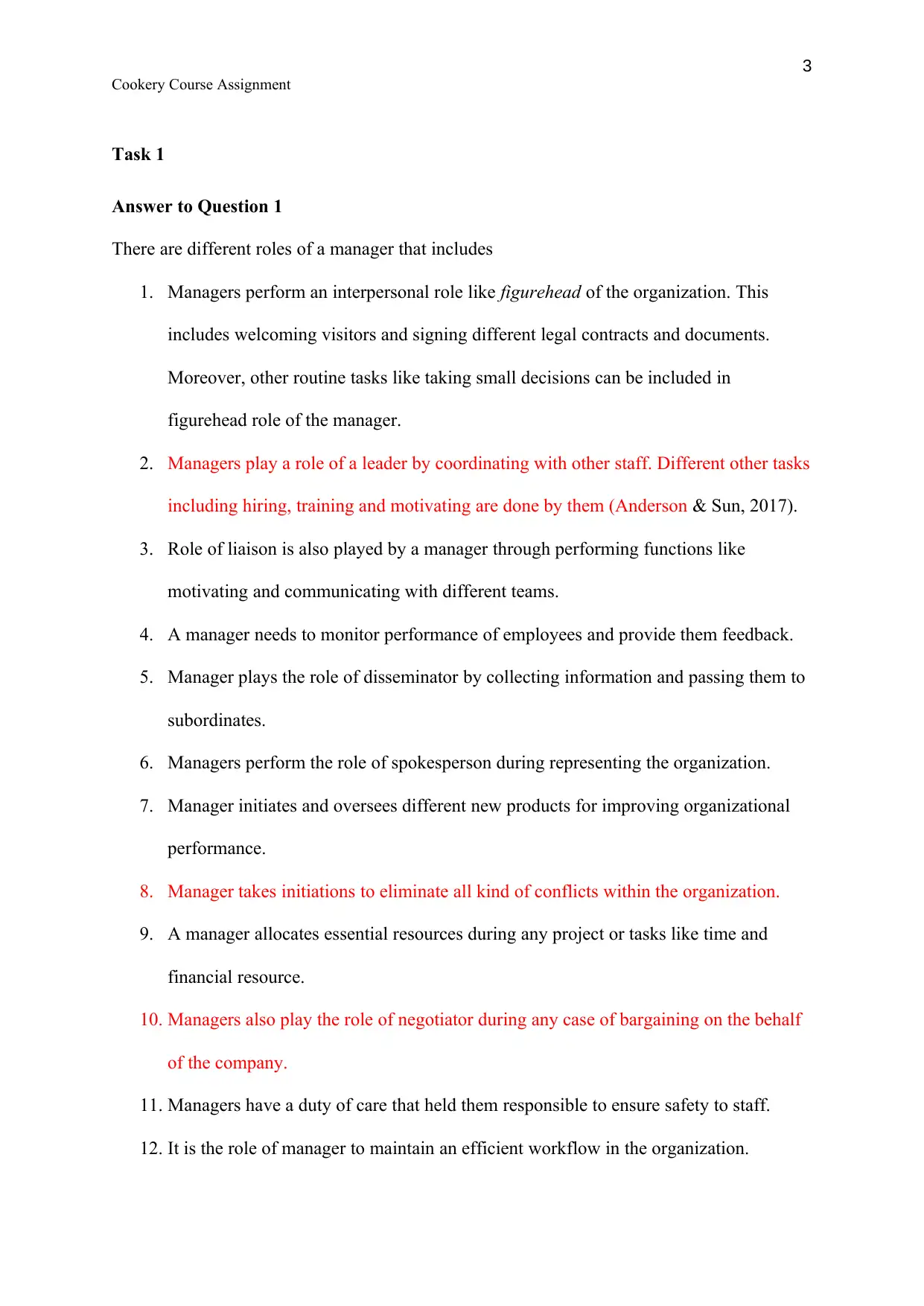
3
Cookery Course Assignment
Task 1
Answer to Question 1
There are different roles of a manager that includes
1. Managers perform an interpersonal role like figurehead of the organization. This
includes welcoming visitors and signing different legal contracts and documents.
Moreover, other routine tasks like taking small decisions can be included in
figurehead role of the manager.
2. Managers play a role of a leader by coordinating with other staff. Different other tasks
including hiring, training and motivating are done by them (Anderson & Sun, 2017).
3. Role of liaison is also played by a manager through performing functions like
motivating and communicating with different teams.
4. A manager needs to monitor performance of employees and provide them feedback.
5. Manager plays the role of disseminator by collecting information and passing them to
subordinates.
6. Managers perform the role of spokesperson during representing the organization.
7. Manager initiates and oversees different new products for improving organizational
performance.
8. Manager takes initiations to eliminate all kind of conflicts within the organization.
9. A manager allocates essential resources during any project or tasks like time and
financial resource.
10. Managers also play the role of negotiator during any case of bargaining on the behalf
of the company.
11. Managers have a duty of care that held them responsible to ensure safety to staff.
12. It is the role of manager to maintain an efficient workflow in the organization.
Cookery Course Assignment
Task 1
Answer to Question 1
There are different roles of a manager that includes
1. Managers perform an interpersonal role like figurehead of the organization. This
includes welcoming visitors and signing different legal contracts and documents.
Moreover, other routine tasks like taking small decisions can be included in
figurehead role of the manager.
2. Managers play a role of a leader by coordinating with other staff. Different other tasks
including hiring, training and motivating are done by them (Anderson & Sun, 2017).
3. Role of liaison is also played by a manager through performing functions like
motivating and communicating with different teams.
4. A manager needs to monitor performance of employees and provide them feedback.
5. Manager plays the role of disseminator by collecting information and passing them to
subordinates.
6. Managers perform the role of spokesperson during representing the organization.
7. Manager initiates and oversees different new products for improving organizational
performance.
8. Manager takes initiations to eliminate all kind of conflicts within the organization.
9. A manager allocates essential resources during any project or tasks like time and
financial resource.
10. Managers also play the role of negotiator during any case of bargaining on the behalf
of the company.
11. Managers have a duty of care that held them responsible to ensure safety to staff.
12. It is the role of manager to maintain an efficient workflow in the organization.
⊘ This is a preview!⊘
Do you want full access?
Subscribe today to unlock all pages.

Trusted by 1+ million students worldwide
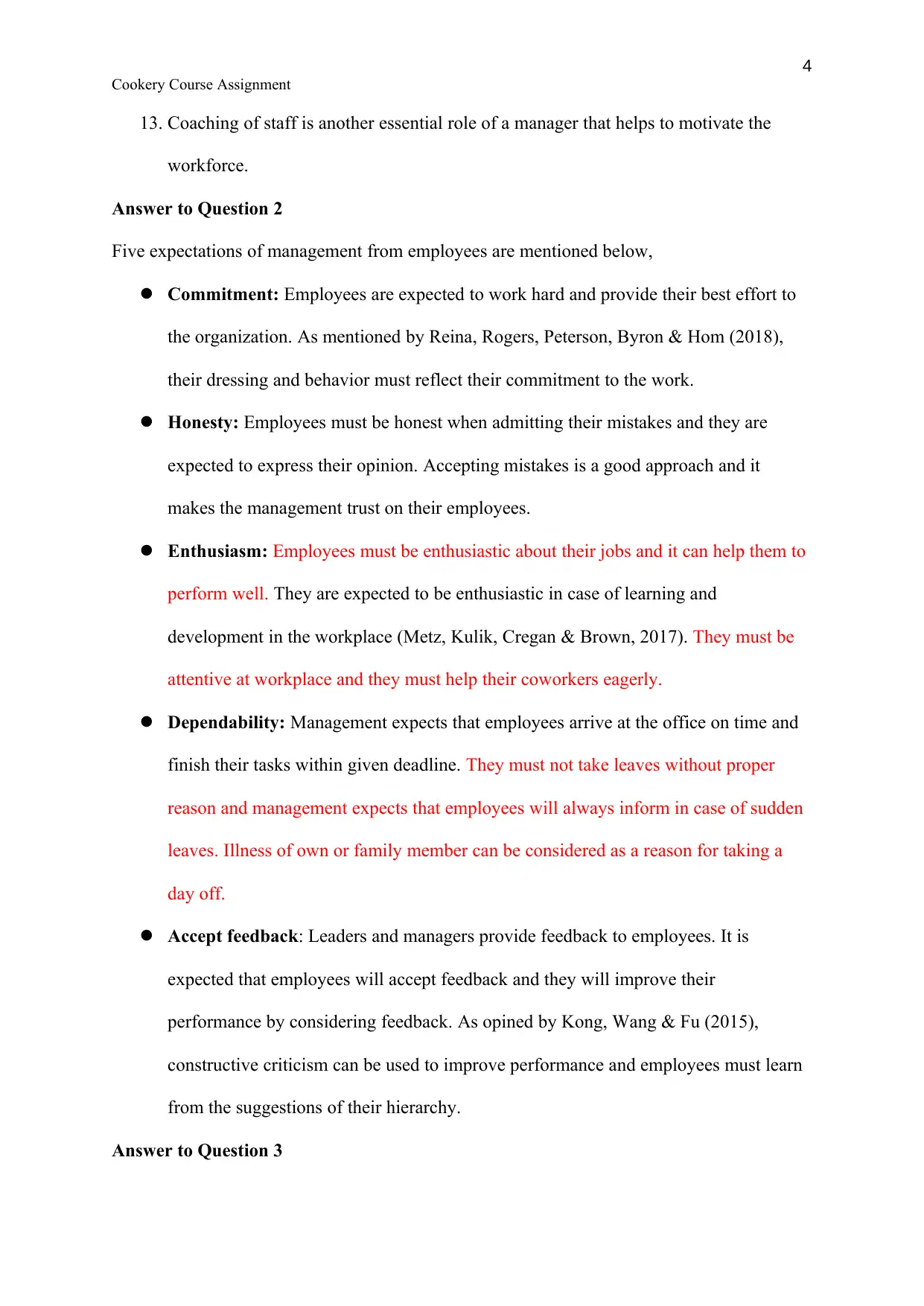
4
Cookery Course Assignment
13. Coaching of staff is another essential role of a manager that helps to motivate the
workforce.
Answer to Question 2
Five expectations of management from employees are mentioned below,
Commitment: Employees are expected to work hard and provide their best effort to
the organization. As mentioned by Reina, Rogers, Peterson, Byron & Hom (2018),
their dressing and behavior must reflect their commitment to the work.
Honesty: Employees must be honest when admitting their mistakes and they are
expected to express their opinion. Accepting mistakes is a good approach and it
makes the management trust on their employees.
Enthusiasm: Employees must be enthusiastic about their jobs and it can help them to
perform well. They are expected to be enthusiastic in case of learning and
development in the workplace (Metz, Kulik, Cregan & Brown, 2017). They must be
attentive at workplace and they must help their coworkers eagerly.
Dependability: Management expects that employees arrive at the office on time and
finish their tasks within given deadline. They must not take leaves without proper
reason and management expects that employees will always inform in case of sudden
leaves. Illness of own or family member can be considered as a reason for taking a
day off.
Accept feedback: Leaders and managers provide feedback to employees. It is
expected that employees will accept feedback and they will improve their
performance by considering feedback. As opined by Kong, Wang & Fu (2015),
constructive criticism can be used to improve performance and employees must learn
from the suggestions of their hierarchy.
Answer to Question 3
Cookery Course Assignment
13. Coaching of staff is another essential role of a manager that helps to motivate the
workforce.
Answer to Question 2
Five expectations of management from employees are mentioned below,
Commitment: Employees are expected to work hard and provide their best effort to
the organization. As mentioned by Reina, Rogers, Peterson, Byron & Hom (2018),
their dressing and behavior must reflect their commitment to the work.
Honesty: Employees must be honest when admitting their mistakes and they are
expected to express their opinion. Accepting mistakes is a good approach and it
makes the management trust on their employees.
Enthusiasm: Employees must be enthusiastic about their jobs and it can help them to
perform well. They are expected to be enthusiastic in case of learning and
development in the workplace (Metz, Kulik, Cregan & Brown, 2017). They must be
attentive at workplace and they must help their coworkers eagerly.
Dependability: Management expects that employees arrive at the office on time and
finish their tasks within given deadline. They must not take leaves without proper
reason and management expects that employees will always inform in case of sudden
leaves. Illness of own or family member can be considered as a reason for taking a
day off.
Accept feedback: Leaders and managers provide feedback to employees. It is
expected that employees will accept feedback and they will improve their
performance by considering feedback. As opined by Kong, Wang & Fu (2015),
constructive criticism can be used to improve performance and employees must learn
from the suggestions of their hierarchy.
Answer to Question 3
Paraphrase This Document
Need a fresh take? Get an instant paraphrase of this document with our AI Paraphraser
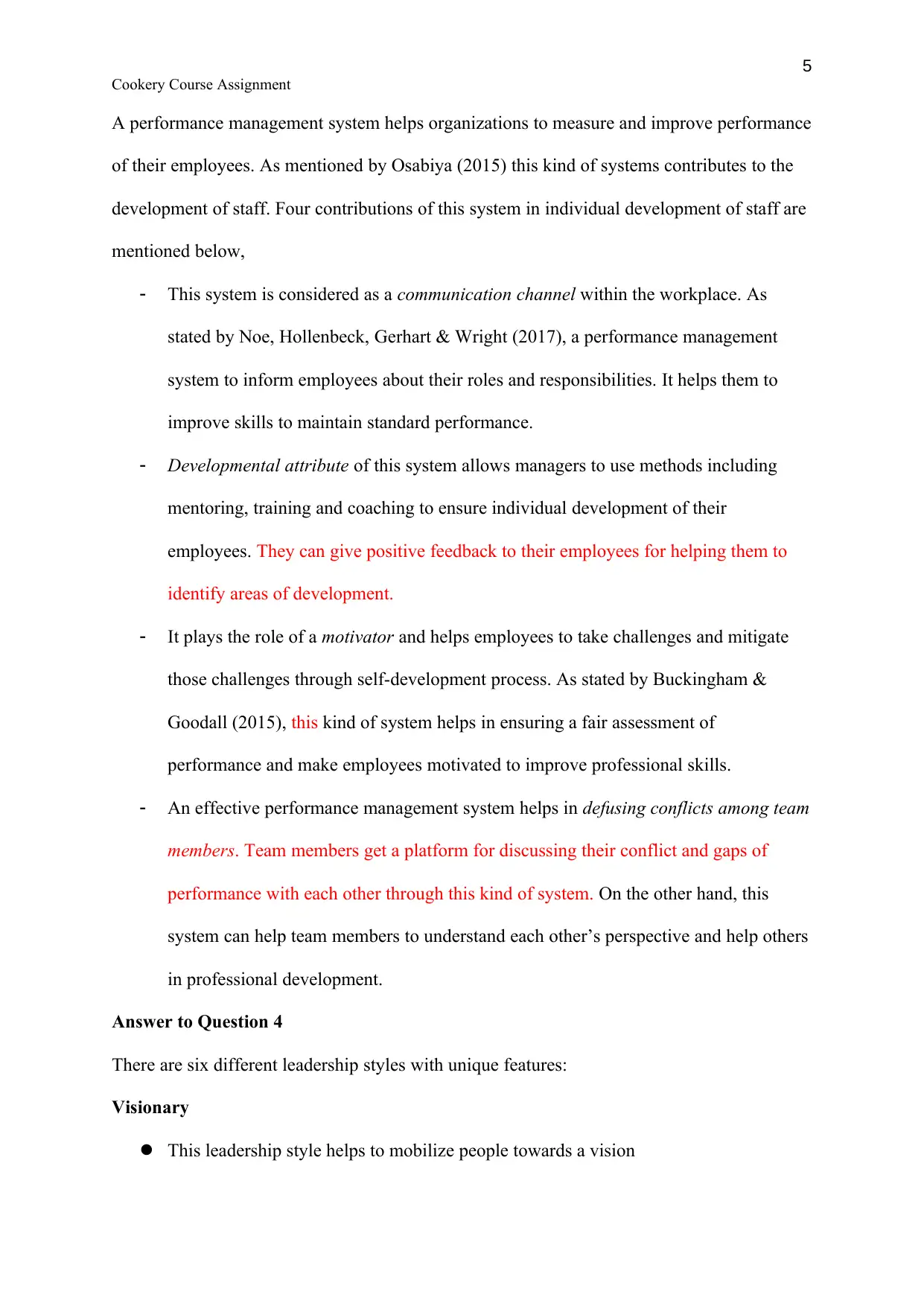
5
Cookery Course Assignment
A performance management system helps organizations to measure and improve performance
of their employees. As mentioned by Osabiya (2015) this kind of systems contributes to the
development of staff. Four contributions of this system in individual development of staff are
mentioned below,
- This system is considered as a communication channel within the workplace. As
stated by Noe, Hollenbeck, Gerhart & Wright (2017), a performance management
system to inform employees about their roles and responsibilities. It helps them to
improve skills to maintain standard performance.
- Developmental attribute of this system allows managers to use methods including
mentoring, training and coaching to ensure individual development of their
employees. They can give positive feedback to their employees for helping them to
identify areas of development.
- It plays the role of a motivator and helps employees to take challenges and mitigate
those challenges through self-development process. As stated by Buckingham &
Goodall (2015), this kind of system helps in ensuring a fair assessment of
performance and make employees motivated to improve professional skills.
- An effective performance management system helps in defusing conflicts among team
members. Team members get a platform for discussing their conflict and gaps of
performance with each other through this kind of system. On the other hand, this
system can help team members to understand each other’s perspective and help others
in professional development.
Answer to Question 4
There are six different leadership styles with unique features:
Visionary
This leadership style helps to mobilize people towards a vision
Cookery Course Assignment
A performance management system helps organizations to measure and improve performance
of their employees. As mentioned by Osabiya (2015) this kind of systems contributes to the
development of staff. Four contributions of this system in individual development of staff are
mentioned below,
- This system is considered as a communication channel within the workplace. As
stated by Noe, Hollenbeck, Gerhart & Wright (2017), a performance management
system to inform employees about their roles and responsibilities. It helps them to
improve skills to maintain standard performance.
- Developmental attribute of this system allows managers to use methods including
mentoring, training and coaching to ensure individual development of their
employees. They can give positive feedback to their employees for helping them to
identify areas of development.
- It plays the role of a motivator and helps employees to take challenges and mitigate
those challenges through self-development process. As stated by Buckingham &
Goodall (2015), this kind of system helps in ensuring a fair assessment of
performance and make employees motivated to improve professional skills.
- An effective performance management system helps in defusing conflicts among team
members. Team members get a platform for discussing their conflict and gaps of
performance with each other through this kind of system. On the other hand, this
system can help team members to understand each other’s perspective and help others
in professional development.
Answer to Question 4
There are six different leadership styles with unique features:
Visionary
This leadership style helps to mobilize people towards a vision
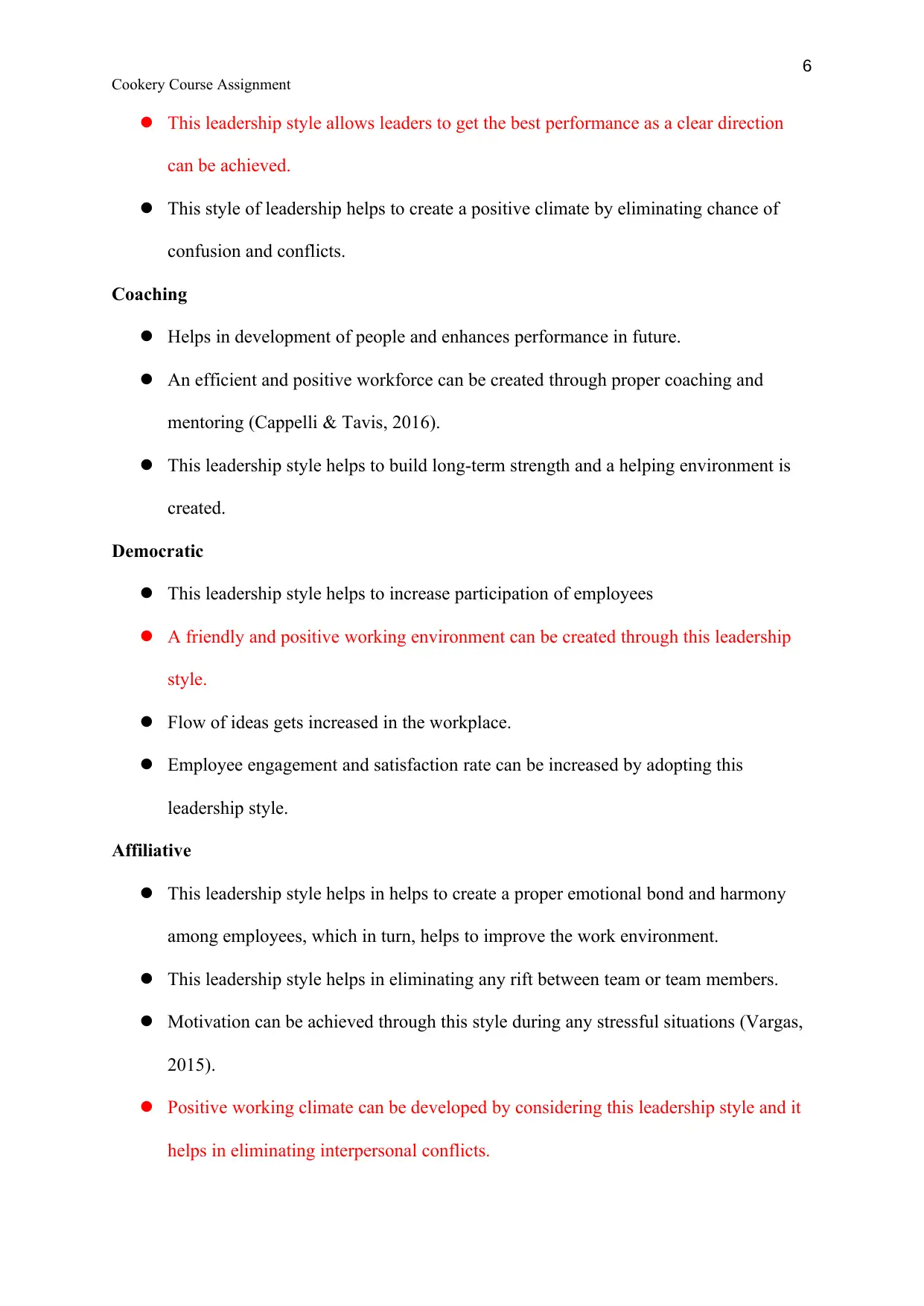
6
Cookery Course Assignment
This leadership style allows leaders to get the best performance as a clear direction
can be achieved.
This style of leadership helps to create a positive climate by eliminating chance of
confusion and conflicts.
Coaching
Helps in development of people and enhances performance in future.
An efficient and positive workforce can be created through proper coaching and
mentoring (Cappelli & Tavis, 2016).
This leadership style helps to build long-term strength and a helping environment is
created.
Democratic
This leadership style helps to increase participation of employees
A friendly and positive working environment can be created through this leadership
style.
Flow of ideas gets increased in the workplace.
Employee engagement and satisfaction rate can be increased by adopting this
leadership style.
Affiliative
This leadership style helps in helps to create a proper emotional bond and harmony
among employees, which in turn, helps to improve the work environment.
This leadership style helps in eliminating any rift between team or team members.
Motivation can be achieved through this style during any stressful situations (Vargas,
2015).
Positive working climate can be developed by considering this leadership style and it
helps in eliminating interpersonal conflicts.
Cookery Course Assignment
This leadership style allows leaders to get the best performance as a clear direction
can be achieved.
This style of leadership helps to create a positive climate by eliminating chance of
confusion and conflicts.
Coaching
Helps in development of people and enhances performance in future.
An efficient and positive workforce can be created through proper coaching and
mentoring (Cappelli & Tavis, 2016).
This leadership style helps to build long-term strength and a helping environment is
created.
Democratic
This leadership style helps to increase participation of employees
A friendly and positive working environment can be created through this leadership
style.
Flow of ideas gets increased in the workplace.
Employee engagement and satisfaction rate can be increased by adopting this
leadership style.
Affiliative
This leadership style helps in helps to create a proper emotional bond and harmony
among employees, which in turn, helps to improve the work environment.
This leadership style helps in eliminating any rift between team or team members.
Motivation can be achieved through this style during any stressful situations (Vargas,
2015).
Positive working climate can be developed by considering this leadership style and it
helps in eliminating interpersonal conflicts.
⊘ This is a preview!⊘
Do you want full access?
Subscribe today to unlock all pages.

Trusted by 1+ million students worldwide
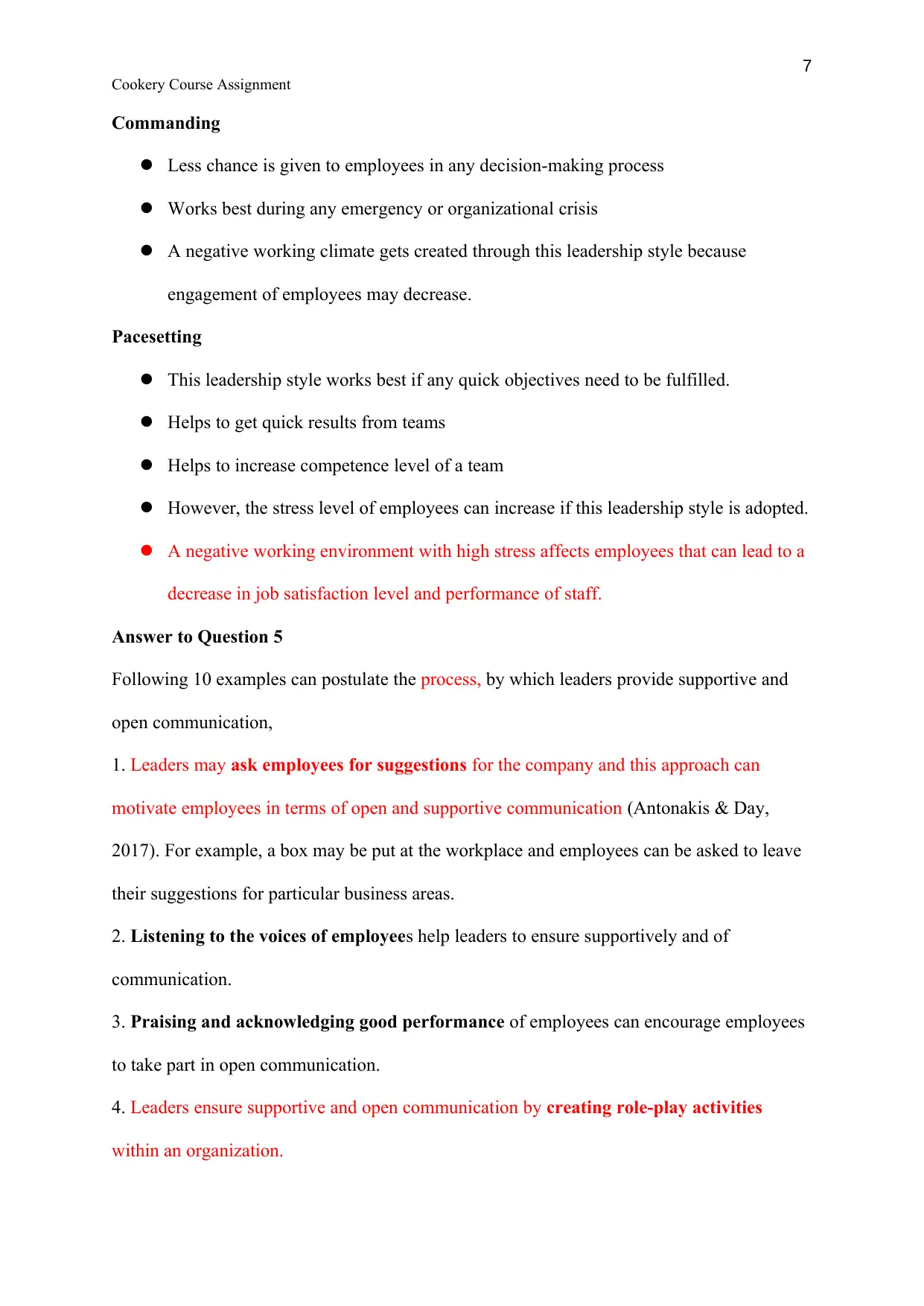
7
Cookery Course Assignment
Commanding
Less chance is given to employees in any decision-making process
Works best during any emergency or organizational crisis
A negative working climate gets created through this leadership style because
engagement of employees may decrease.
Pacesetting
This leadership style works best if any quick objectives need to be fulfilled.
Helps to get quick results from teams
Helps to increase competence level of a team
However, the stress level of employees can increase if this leadership style is adopted.
A negative working environment with high stress affects employees that can lead to a
decrease in job satisfaction level and performance of staff.
Answer to Question 5
Following 10 examples can postulate the process, by which leaders provide supportive and
open communication,
1. Leaders may ask employees for suggestions for the company and this approach can
motivate employees in terms of open and supportive communication (Antonakis & Day,
2017). For example, a box may be put at the workplace and employees can be asked to leave
their suggestions for particular business areas.
2. Listening to the voices of employees help leaders to ensure supportively and of
communication.
3. Praising and acknowledging good performance of employees can encourage employees
to take part in open communication.
4. Leaders ensure supportive and open communication by creating role-play activities
within an organization.
Cookery Course Assignment
Commanding
Less chance is given to employees in any decision-making process
Works best during any emergency or organizational crisis
A negative working climate gets created through this leadership style because
engagement of employees may decrease.
Pacesetting
This leadership style works best if any quick objectives need to be fulfilled.
Helps to get quick results from teams
Helps to increase competence level of a team
However, the stress level of employees can increase if this leadership style is adopted.
A negative working environment with high stress affects employees that can lead to a
decrease in job satisfaction level and performance of staff.
Answer to Question 5
Following 10 examples can postulate the process, by which leaders provide supportive and
open communication,
1. Leaders may ask employees for suggestions for the company and this approach can
motivate employees in terms of open and supportive communication (Antonakis & Day,
2017). For example, a box may be put at the workplace and employees can be asked to leave
their suggestions for particular business areas.
2. Listening to the voices of employees help leaders to ensure supportively and of
communication.
3. Praising and acknowledging good performance of employees can encourage employees
to take part in open communication.
4. Leaders ensure supportive and open communication by creating role-play activities
within an organization.
Paraphrase This Document
Need a fresh take? Get an instant paraphrase of this document with our AI Paraphraser
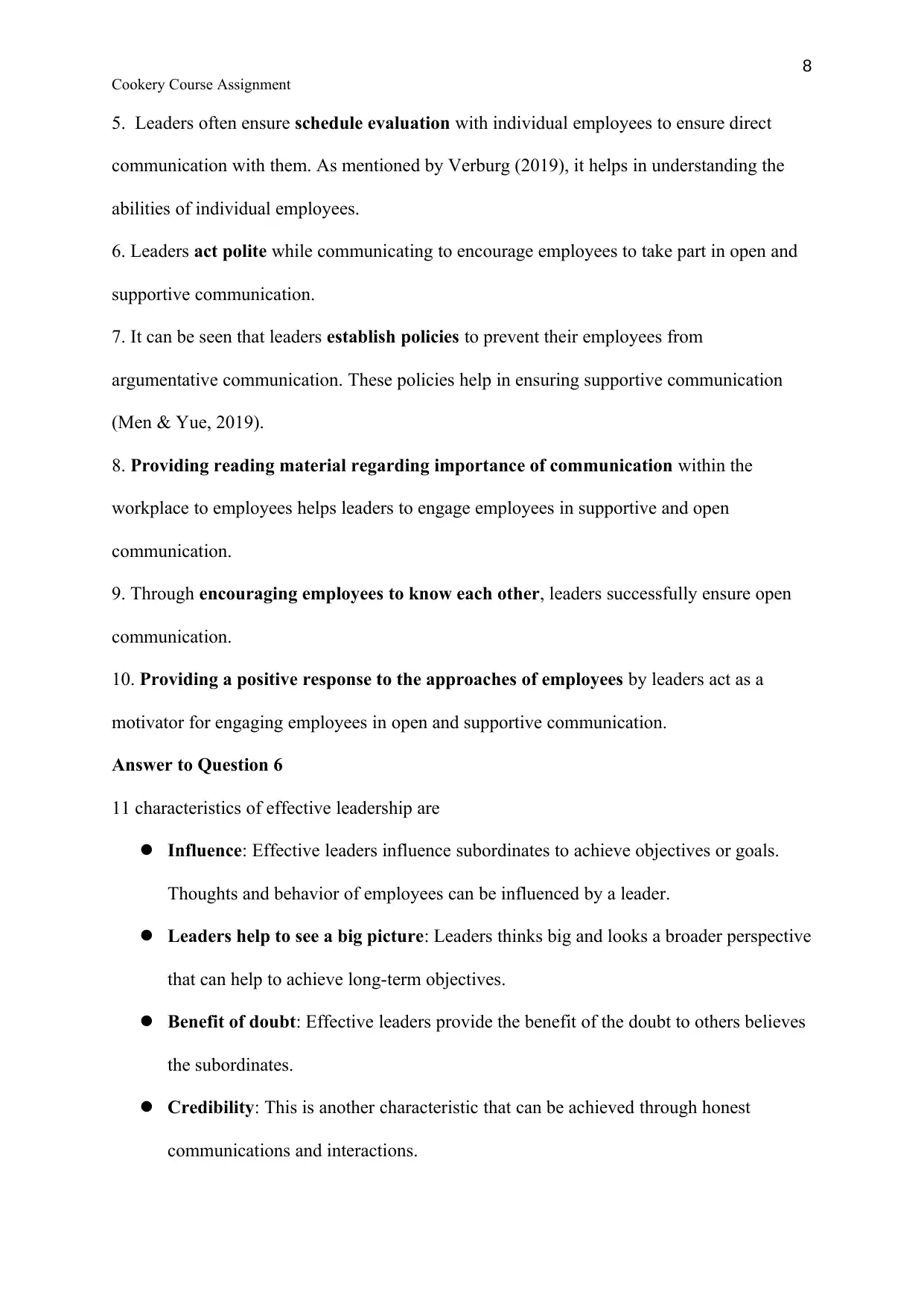
8
Cookery Course Assignment
5. Leaders often ensure schedule evaluation with individual employees to ensure direct
communication with them. As mentioned by Verburg (2019), it helps in understanding the
abilities of individual employees.
6. Leaders act polite while communicating to encourage employees to take part in open and
supportive communication.
7. It can be seen that leaders establish policies to prevent their employees from
argumentative communication. These policies help in ensuring supportive communication
(Men & Yue, 2019).
8. Providing reading material regarding importance of communication within the
workplace to employees helps leaders to engage employees in supportive and open
communication.
9. Through encouraging employees to know each other, leaders successfully ensure open
communication.
10. Providing a positive response to the approaches of employees by leaders act as a
motivator for engaging employees in open and supportive communication.
Answer to Question 6
11 characteristics of effective leadership are
Influence: Effective leaders influence subordinates to achieve objectives or goals.
Thoughts and behavior of employees can be influenced by a leader.
Leaders help to see a big picture: Leaders thinks big and looks a broader perspective
that can help to achieve long-term objectives.
Benefit of doubt: Effective leaders provide the benefit of the doubt to others believes
the subordinates.
Credibility: This is another characteristic that can be achieved through honest
communications and interactions.
Cookery Course Assignment
5. Leaders often ensure schedule evaluation with individual employees to ensure direct
communication with them. As mentioned by Verburg (2019), it helps in understanding the
abilities of individual employees.
6. Leaders act polite while communicating to encourage employees to take part in open and
supportive communication.
7. It can be seen that leaders establish policies to prevent their employees from
argumentative communication. These policies help in ensuring supportive communication
(Men & Yue, 2019).
8. Providing reading material regarding importance of communication within the
workplace to employees helps leaders to engage employees in supportive and open
communication.
9. Through encouraging employees to know each other, leaders successfully ensure open
communication.
10. Providing a positive response to the approaches of employees by leaders act as a
motivator for engaging employees in open and supportive communication.
Answer to Question 6
11 characteristics of effective leadership are
Influence: Effective leaders influence subordinates to achieve objectives or goals.
Thoughts and behavior of employees can be influenced by a leader.
Leaders help to see a big picture: Leaders thinks big and looks a broader perspective
that can help to achieve long-term objectives.
Benefit of doubt: Effective leaders provide the benefit of the doubt to others believes
the subordinates.
Credibility: This is another characteristic that can be achieved through honest
communications and interactions.
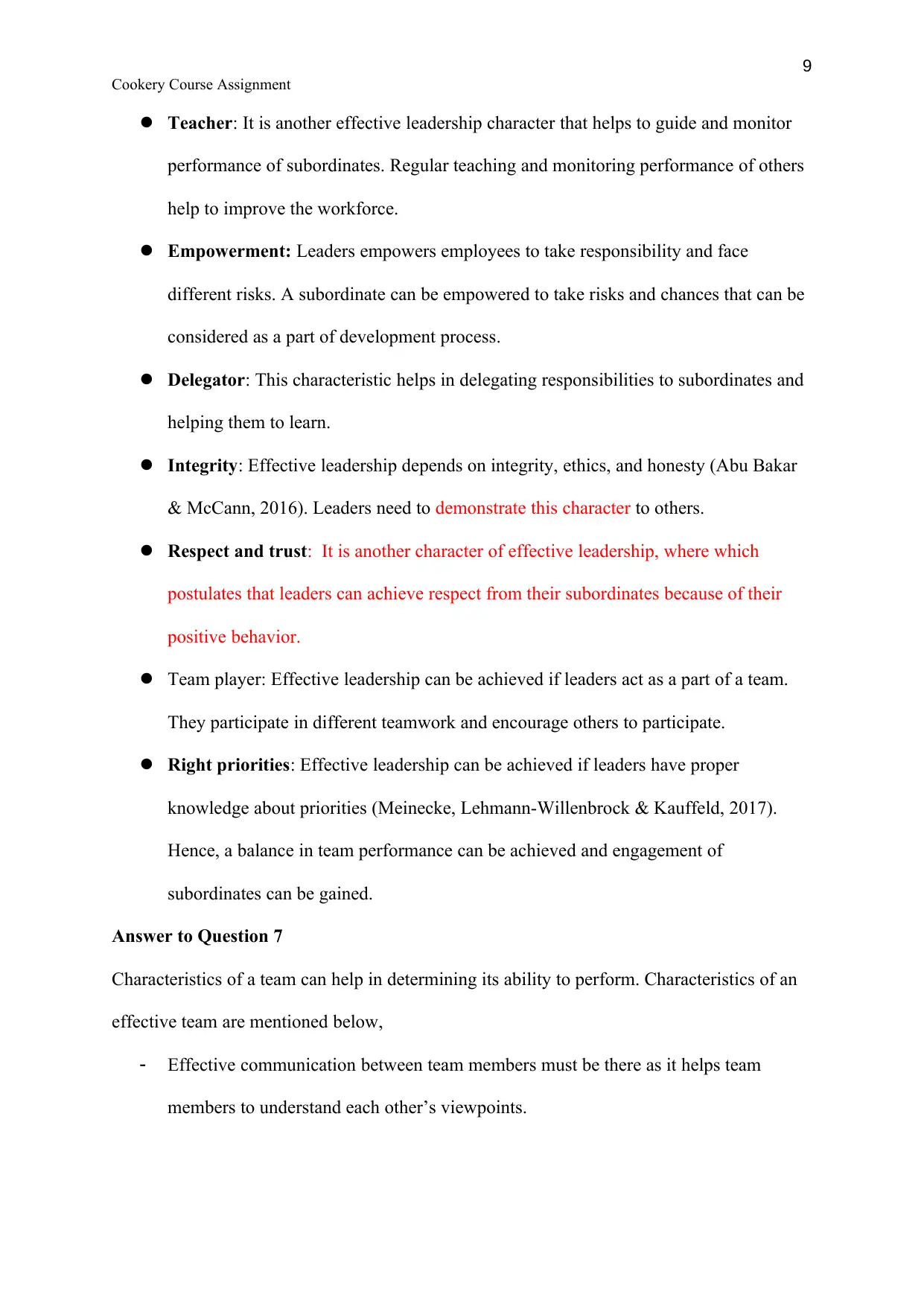
9
Cookery Course Assignment
Teacher: It is another effective leadership character that helps to guide and monitor
performance of subordinates. Regular teaching and monitoring performance of others
help to improve the workforce.
Empowerment: Leaders empowers employees to take responsibility and face
different risks. A subordinate can be empowered to take risks and chances that can be
considered as a part of development process.
Delegator: This characteristic helps in delegating responsibilities to subordinates and
helping them to learn.
Integrity: Effective leadership depends on integrity, ethics, and honesty (Abu Bakar
& McCann, 2016). Leaders need to demonstrate this character to others.
Respect and trust: It is another character of effective leadership, where which
postulates that leaders can achieve respect from their subordinates because of their
positive behavior.
Team player: Effective leadership can be achieved if leaders act as a part of a team.
They participate in different teamwork and encourage others to participate.
Right priorities: Effective leadership can be achieved if leaders have proper
knowledge about priorities (Meinecke, Lehmann-Willenbrock & Kauffeld, 2017).
Hence, a balance in team performance can be achieved and engagement of
subordinates can be gained.
Answer to Question 7
Characteristics of a team can help in determining its ability to perform. Characteristics of an
effective team are mentioned below,
- Effective communication between team members must be there as it helps team
members to understand each other’s viewpoints.
Cookery Course Assignment
Teacher: It is another effective leadership character that helps to guide and monitor
performance of subordinates. Regular teaching and monitoring performance of others
help to improve the workforce.
Empowerment: Leaders empowers employees to take responsibility and face
different risks. A subordinate can be empowered to take risks and chances that can be
considered as a part of development process.
Delegator: This characteristic helps in delegating responsibilities to subordinates and
helping them to learn.
Integrity: Effective leadership depends on integrity, ethics, and honesty (Abu Bakar
& McCann, 2016). Leaders need to demonstrate this character to others.
Respect and trust: It is another character of effective leadership, where which
postulates that leaders can achieve respect from their subordinates because of their
positive behavior.
Team player: Effective leadership can be achieved if leaders act as a part of a team.
They participate in different teamwork and encourage others to participate.
Right priorities: Effective leadership can be achieved if leaders have proper
knowledge about priorities (Meinecke, Lehmann-Willenbrock & Kauffeld, 2017).
Hence, a balance in team performance can be achieved and engagement of
subordinates can be gained.
Answer to Question 7
Characteristics of a team can help in determining its ability to perform. Characteristics of an
effective team are mentioned below,
- Effective communication between team members must be there as it helps team
members to understand each other’s viewpoints.
⊘ This is a preview!⊘
Do you want full access?
Subscribe today to unlock all pages.

Trusted by 1+ million students worldwide
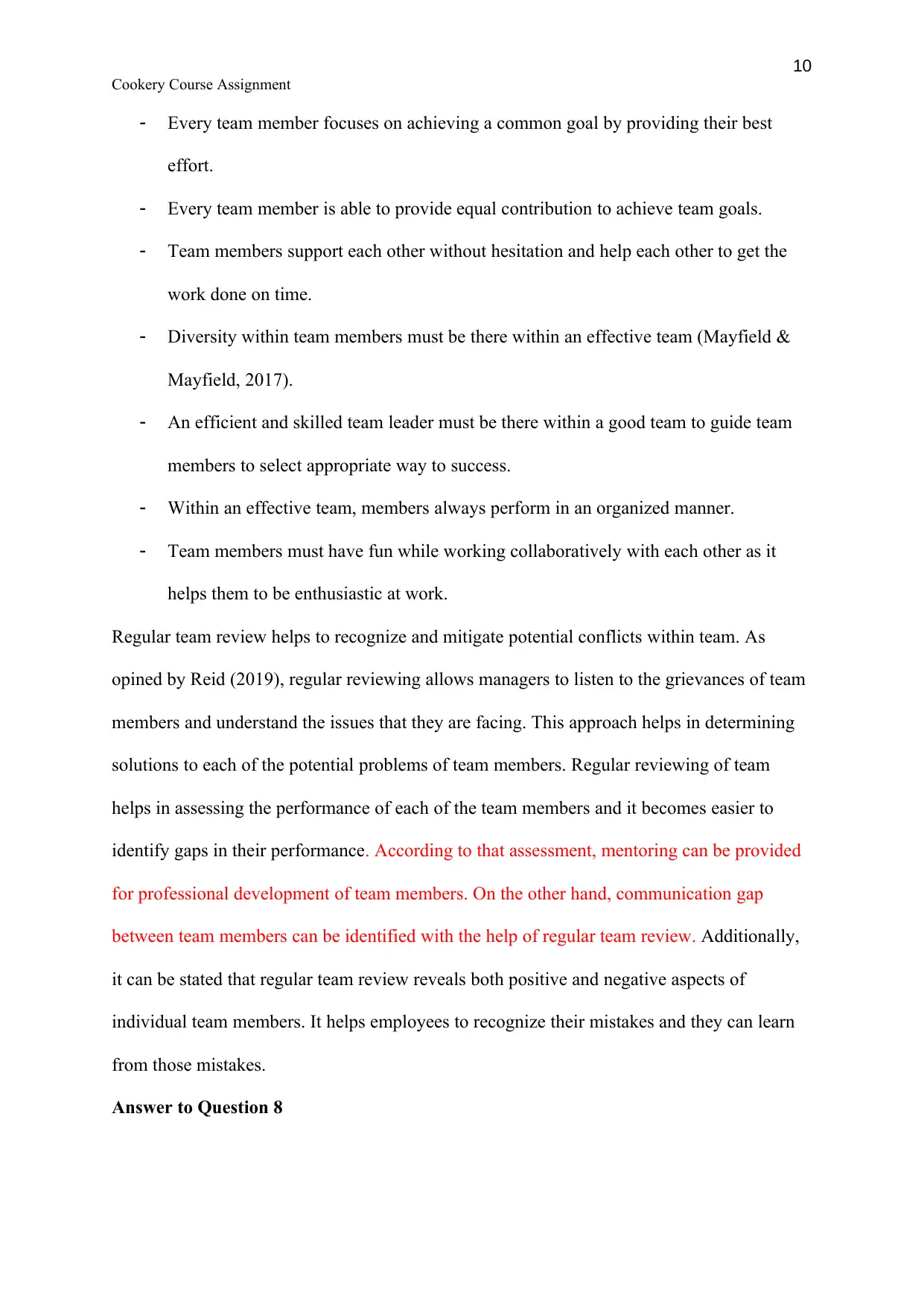
10
Cookery Course Assignment
- Every team member focuses on achieving a common goal by providing their best
effort.
- Every team member is able to provide equal contribution to achieve team goals.
- Team members support each other without hesitation and help each other to get the
work done on time.
- Diversity within team members must be there within an effective team (Mayfield &
Mayfield, 2017).
- An efficient and skilled team leader must be there within a good team to guide team
members to select appropriate way to success.
- Within an effective team, members always perform in an organized manner.
- Team members must have fun while working collaboratively with each other as it
helps them to be enthusiastic at work.
Regular team review helps to recognize and mitigate potential conflicts within team. As
opined by Reid (2019), regular reviewing allows managers to listen to the grievances of team
members and understand the issues that they are facing. This approach helps in determining
solutions to each of the potential problems of team members. Regular reviewing of team
helps in assessing the performance of each of the team members and it becomes easier to
identify gaps in their performance. According to that assessment, mentoring can be provided
for professional development of team members. On the other hand, communication gap
between team members can be identified with the help of regular team review. Additionally,
it can be stated that regular team review reveals both positive and negative aspects of
individual team members. It helps employees to recognize their mistakes and they can learn
from those mistakes.
Answer to Question 8
Cookery Course Assignment
- Every team member focuses on achieving a common goal by providing their best
effort.
- Every team member is able to provide equal contribution to achieve team goals.
- Team members support each other without hesitation and help each other to get the
work done on time.
- Diversity within team members must be there within an effective team (Mayfield &
Mayfield, 2017).
- An efficient and skilled team leader must be there within a good team to guide team
members to select appropriate way to success.
- Within an effective team, members always perform in an organized manner.
- Team members must have fun while working collaboratively with each other as it
helps them to be enthusiastic at work.
Regular team review helps to recognize and mitigate potential conflicts within team. As
opined by Reid (2019), regular reviewing allows managers to listen to the grievances of team
members and understand the issues that they are facing. This approach helps in determining
solutions to each of the potential problems of team members. Regular reviewing of team
helps in assessing the performance of each of the team members and it becomes easier to
identify gaps in their performance. According to that assessment, mentoring can be provided
for professional development of team members. On the other hand, communication gap
between team members can be identified with the help of regular team review. Additionally,
it can be stated that regular team review reveals both positive and negative aspects of
individual team members. It helps employees to recognize their mistakes and they can learn
from those mistakes.
Answer to Question 8
Paraphrase This Document
Need a fresh take? Get an instant paraphrase of this document with our AI Paraphraser
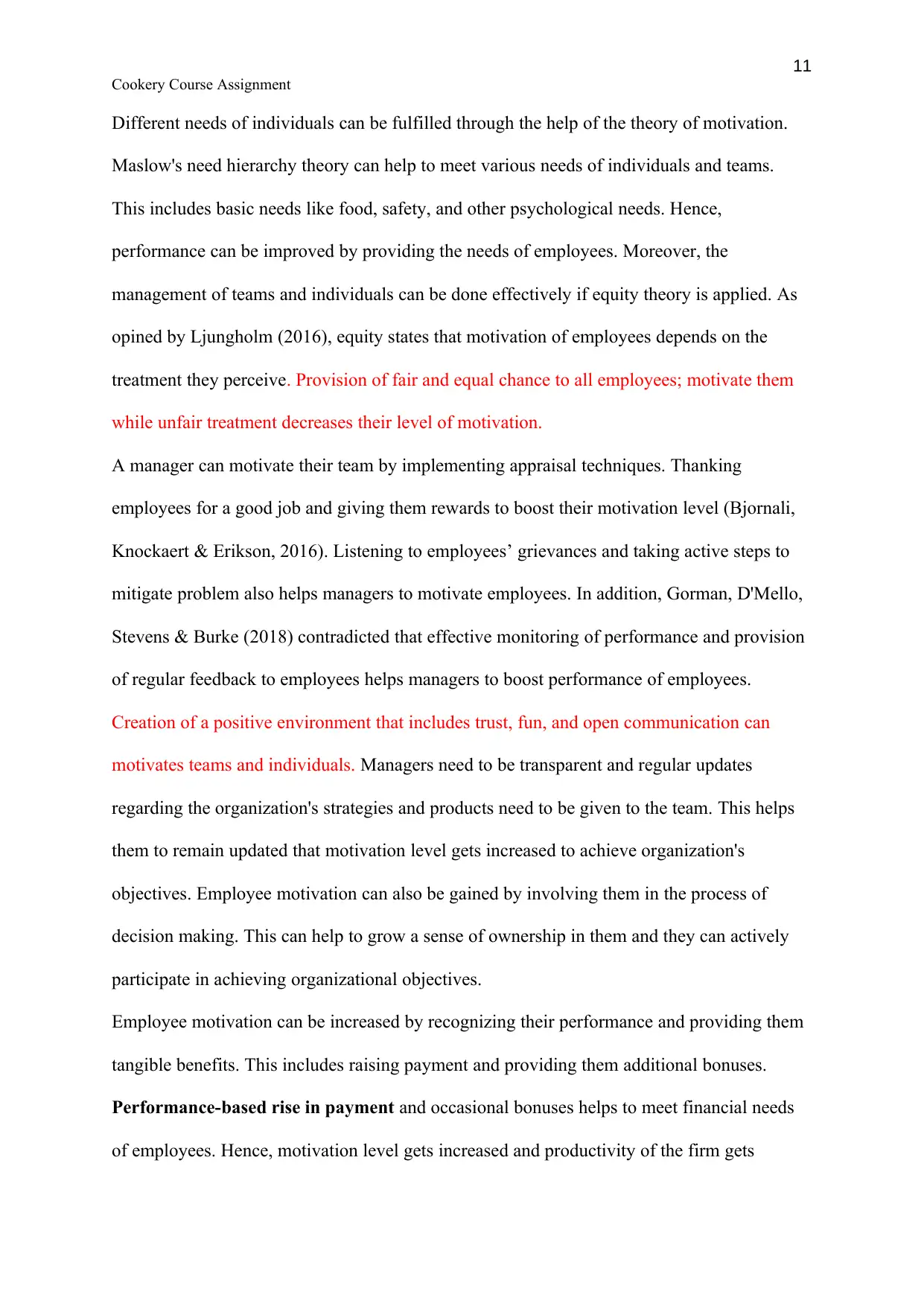
11
Cookery Course Assignment
Different needs of individuals can be fulfilled through the help of the theory of motivation.
Maslow's need hierarchy theory can help to meet various needs of individuals and teams.
This includes basic needs like food, safety, and other psychological needs. Hence,
performance can be improved by providing the needs of employees. Moreover, the
management of teams and individuals can be done effectively if equity theory is applied. As
opined by Ljungholm (2016), equity states that motivation of employees depends on the
treatment they perceive. Provision of fair and equal chance to all employees; motivate them
while unfair treatment decreases their level of motivation.
A manager can motivate their team by implementing appraisal techniques. Thanking
employees for a good job and giving them rewards to boost their motivation level (Bjornali,
Knockaert & Erikson, 2016). Listening to employees’ grievances and taking active steps to
mitigate problem also helps managers to motivate employees. In addition, Gorman, D'Mello,
Stevens & Burke (2018) contradicted that effective monitoring of performance and provision
of regular feedback to employees helps managers to boost performance of employees.
Creation of a positive environment that includes trust, fun, and open communication can
motivates teams and individuals. Managers need to be transparent and regular updates
regarding the organization's strategies and products need to be given to the team. This helps
them to remain updated that motivation level gets increased to achieve organization's
objectives. Employee motivation can also be gained by involving them in the process of
decision making. This can help to grow a sense of ownership in them and they can actively
participate in achieving organizational objectives.
Employee motivation can be increased by recognizing their performance and providing them
tangible benefits. This includes raising payment and providing them additional bonuses.
Performance-based rise in payment and occasional bonuses helps to meet financial needs
of employees. Hence, motivation level gets increased and productivity of the firm gets
Cookery Course Assignment
Different needs of individuals can be fulfilled through the help of the theory of motivation.
Maslow's need hierarchy theory can help to meet various needs of individuals and teams.
This includes basic needs like food, safety, and other psychological needs. Hence,
performance can be improved by providing the needs of employees. Moreover, the
management of teams and individuals can be done effectively if equity theory is applied. As
opined by Ljungholm (2016), equity states that motivation of employees depends on the
treatment they perceive. Provision of fair and equal chance to all employees; motivate them
while unfair treatment decreases their level of motivation.
A manager can motivate their team by implementing appraisal techniques. Thanking
employees for a good job and giving them rewards to boost their motivation level (Bjornali,
Knockaert & Erikson, 2016). Listening to employees’ grievances and taking active steps to
mitigate problem also helps managers to motivate employees. In addition, Gorman, D'Mello,
Stevens & Burke (2018) contradicted that effective monitoring of performance and provision
of regular feedback to employees helps managers to boost performance of employees.
Creation of a positive environment that includes trust, fun, and open communication can
motivates teams and individuals. Managers need to be transparent and regular updates
regarding the organization's strategies and products need to be given to the team. This helps
them to remain updated that motivation level gets increased to achieve organization's
objectives. Employee motivation can also be gained by involving them in the process of
decision making. This can help to grow a sense of ownership in them and they can actively
participate in achieving organizational objectives.
Employee motivation can be increased by recognizing their performance and providing them
tangible benefits. This includes raising payment and providing them additional bonuses.
Performance-based rise in payment and occasional bonuses helps to meet financial needs
of employees. Hence, motivation level gets increased and productivity of the firm gets
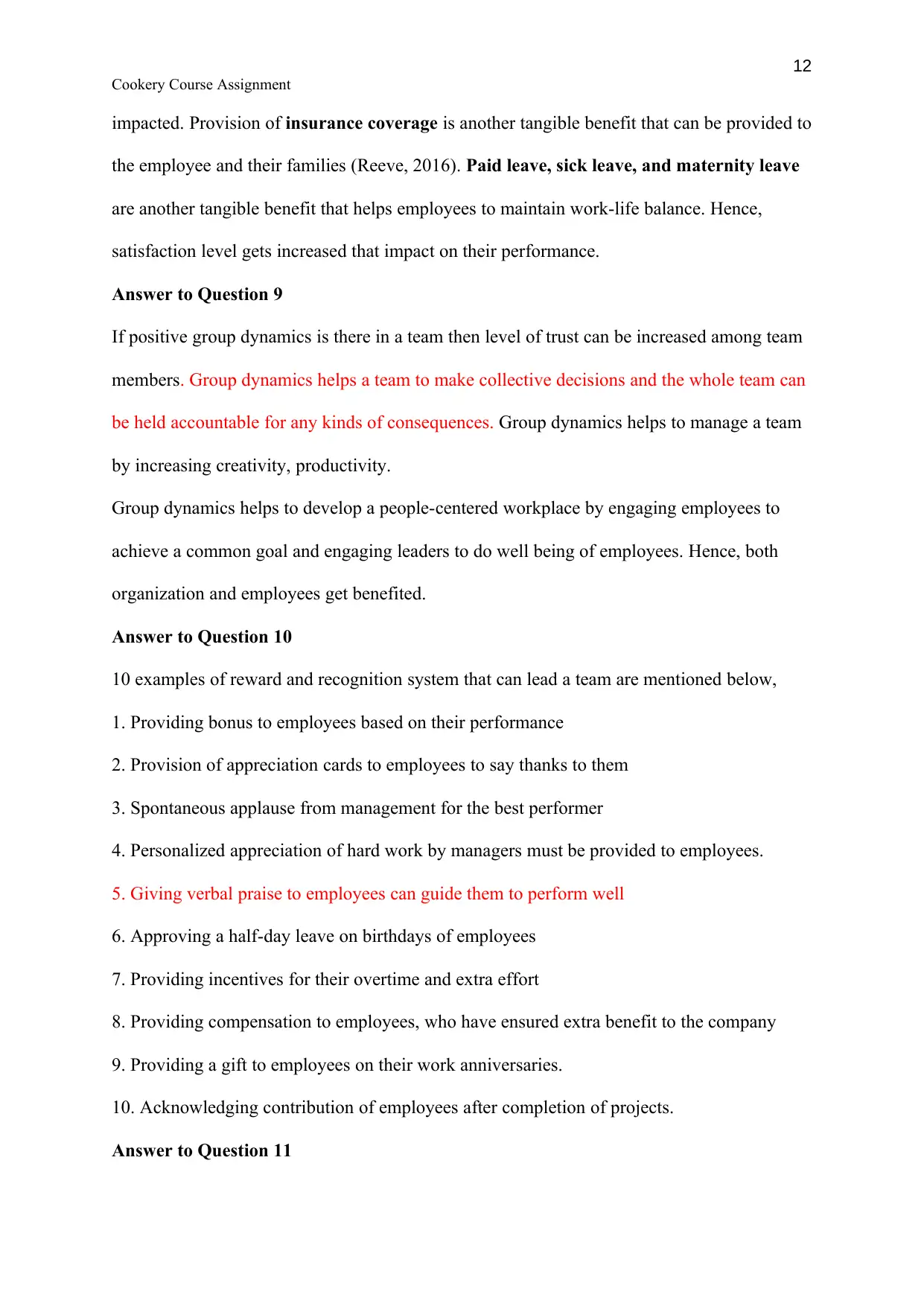
12
Cookery Course Assignment
impacted. Provision of insurance coverage is another tangible benefit that can be provided to
the employee and their families (Reeve, 2016). Paid leave, sick leave, and maternity leave
are another tangible benefit that helps employees to maintain work-life balance. Hence,
satisfaction level gets increased that impact on their performance.
Answer to Question 9
If positive group dynamics is there in a team then level of trust can be increased among team
members. Group dynamics helps a team to make collective decisions and the whole team can
be held accountable for any kinds of consequences. Group dynamics helps to manage a team
by increasing creativity, productivity.
Group dynamics helps to develop a people-centered workplace by engaging employees to
achieve a common goal and engaging leaders to do well being of employees. Hence, both
organization and employees get benefited.
Answer to Question 10
10 examples of reward and recognition system that can lead a team are mentioned below,
1. Providing bonus to employees based on their performance
2. Provision of appreciation cards to employees to say thanks to them
3. Spontaneous applause from management for the best performer
4. Personalized appreciation of hard work by managers must be provided to employees.
5. Giving verbal praise to employees can guide them to perform well
6. Approving a half-day leave on birthdays of employees
7. Providing incentives for their overtime and extra effort
8. Providing compensation to employees, who have ensured extra benefit to the company
9. Providing a gift to employees on their work anniversaries.
10. Acknowledging contribution of employees after completion of projects.
Answer to Question 11
Cookery Course Assignment
impacted. Provision of insurance coverage is another tangible benefit that can be provided to
the employee and their families (Reeve, 2016). Paid leave, sick leave, and maternity leave
are another tangible benefit that helps employees to maintain work-life balance. Hence,
satisfaction level gets increased that impact on their performance.
Answer to Question 9
If positive group dynamics is there in a team then level of trust can be increased among team
members. Group dynamics helps a team to make collective decisions and the whole team can
be held accountable for any kinds of consequences. Group dynamics helps to manage a team
by increasing creativity, productivity.
Group dynamics helps to develop a people-centered workplace by engaging employees to
achieve a common goal and engaging leaders to do well being of employees. Hence, both
organization and employees get benefited.
Answer to Question 10
10 examples of reward and recognition system that can lead a team are mentioned below,
1. Providing bonus to employees based on their performance
2. Provision of appreciation cards to employees to say thanks to them
3. Spontaneous applause from management for the best performer
4. Personalized appreciation of hard work by managers must be provided to employees.
5. Giving verbal praise to employees can guide them to perform well
6. Approving a half-day leave on birthdays of employees
7. Providing incentives for their overtime and extra effort
8. Providing compensation to employees, who have ensured extra benefit to the company
9. Providing a gift to employees on their work anniversaries.
10. Acknowledging contribution of employees after completion of projects.
Answer to Question 11
⊘ This is a preview!⊘
Do you want full access?
Subscribe today to unlock all pages.

Trusted by 1+ million students worldwide
1 out of 23
Related Documents
Your All-in-One AI-Powered Toolkit for Academic Success.
+13062052269
info@desklib.com
Available 24*7 on WhatsApp / Email
![[object Object]](/_next/static/media/star-bottom.7253800d.svg)
Unlock your academic potential
Copyright © 2020–2025 A2Z Services. All Rights Reserved. Developed and managed by ZUCOL.




